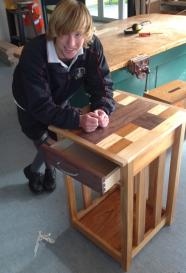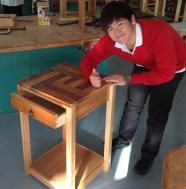Recording evidence in designing materials outcomes using iCoach
Teaching inquiry
How can I reduce the burden of evidence gathering in a written form, particularly for students who are not strong in literacy?
Introduction
Teacher James Woodford has achieved great results with his year 11 hard materials students by:
- communicating high expectations
- actively teaching a design approach
- exploring design ideas
- using an app to support evidence gathering.
This teaching snapshot is an example of assessment for learning.
Strategy

James teaches senior technology at Mount Maunganui College. A qualified furniture maker, he is keen to see students taking ownership of their work by designing and producing quality outcomes of their own choice.
James’s year 11 programme is based around designing and developing a chair and a table. He begins by introducing students to the design process, drawing skills, and construction techniques – and they then make the chair of their choice. Their achievement is assessed against AS 91057: Implement basic procedures using resistant materials to make a specified product.
AS 91057 work booklet (Word 2007, 365 KB)
Following completion of their chairs, the students make a coffee table as their major project for the year.
Coffee tables are a very suitable year 11 project. They offer plenty of scope for individual design choices, all students can achieve their potential, and everyone ends up with a product that’s worth having. I like the students to do some critical thinking, not just produce a teacher prescribed product. They are taught different construction techniques and then use this knowledge when designing their table.
James Woodford

James also teaches the basics of drawing – oblique, isometric, and perspective – so that the students can give their design ideas shape. If they can’t draw, he believes, they are very dependent on other people's ideas and designs.
Design ideas
To get them thinking about possible designs for their chair and table, James got his students to look at the work of four influential designers that he thought would interest them:
- Gerrit Rietveld, a designer from the Bauhaus era who was into cubism and black and white colours
- Ettore Sottass of Memphis, who used random shapes and patterns
- Renee McIntosh, a more traditional furniture designer
- Quentin Boudois, an influential local moko artist.
Quentin showed us how to draw local designs. The ideas that he gave us were breathtakingly good. Quentin and I worked together on how we could use them in furniture design. The boys could see that the two of us were getting as much out of this as them.
James Woodford
James, Quentin, and the students explored various techniques that could be used to apply te ao Māori design motifs. Some, such as carving, sandblasting, and marquetry (inlay) are exacting and provide a professional finish. Other techniques, such as pokerwork and painting, can look more amateur.

The students then sketched ideas for their chair and table, based on the work of each designer. In all, they each produced about 40 sketches – then chose their favourite concept and went on to produce their chair.
Stakeholders
The table project began with the choice of a stakeholder. These included parents, grandparents, and friends. One student chose to make a table for the school’s reception area. Quentin was his stakeholder because it had design elements that resided with local iwi.
The students interviewed their chosen stakeholder and, in discussion with them, developed specifications for the table. They then refined three concepts and took them back for feedback. When the preferred option and specifications were agreed, and the brief finalised, they went ahead with the construction.
The table project ran over two terms.
Using iCoach to record evidence
James has found that some students who are enthusiastic about the practical side of technology are often very unmotivated when it comes to writing about their work. This can be because they lack good literacy skills.
James is also coach of the First 15 rugby team. He was using iCoach as a means of recording and analysing the team's performance. It occurred to him that his technology students might be able to use the same software to record evidence of their technological practice. This innovation has worked astonishingly well – “I think that this is the best thing I am doing – I am loving it”, says James.
The students have access to an iPad and they use it to video anything that may provide evidence of skills or practice, for example, carving or gluing a joint. Once they have recorded the evidence, they can add commentary, insert arrows to identify a feature (as on sports television), or pause and discuss the action.
I use the software to record construction processes, planning, accuracy in construction, safety in practice, testing, and demonstrating that a product meets the requirements of the brief.
James Woodford
The completed video record is transferred onto a CD. The CDs and the students’ sketches are sent to NZQA as evidence for AS 91047 Undertake development to make a prototype to address a brief and also for AS 91057 Implement basic procedures using resistant materials to make a specified product. This evidence has proved acceptable for moderation purposes.
Outcomes

This is the first year that James has used the level 1 achievement standards. The results for AS 91057 were three Excellences, three Achieved, and the remainder Merits.
Students come in at lunchtime to work on their projects. Some have enhanced their outcomes on their own initiative: “Sir, I was thinking about my project and I have done this …”
High expectations are crucial, says James – “I have shown the boys my own portfolio and they have really bought into it – they know I expect quality.”
Since hearing of the students’ stellar work, the principal was a regular visitor to the classroom. James has also displayed projects in the staffroom. The good vibes have radiated widely, one result being that a large number of year 9 and 10 students now plan to take technology in the senior school.

